The Role of Transformational Leadership in Driving Innovation
VerifiedAdded on 2021/06/17
|9
|2476
|39
Essay
AI Summary
This essay examines the relationship between transformational leadership and innovation, highlighting how leaders can motivate employees, foster creativity, and drive organizational performance. It discusses how transformational leaders establish connections with their subordinates, provide intellectual stimulation, and nurture unique qualities to promote innovation. The essay also provides practical examples of transformational leadership in modern organizations, such as Jeff Bezos at Amazon, Tim Cook at Apple, and Sundar Pichai at Google, illustrating how their leadership styles have increased innovation and revenues. The conclusion emphasizes the important role of transformational leaders in fostering innovation and improving overall organizational performance. The document provides references for the resources used in the essay.
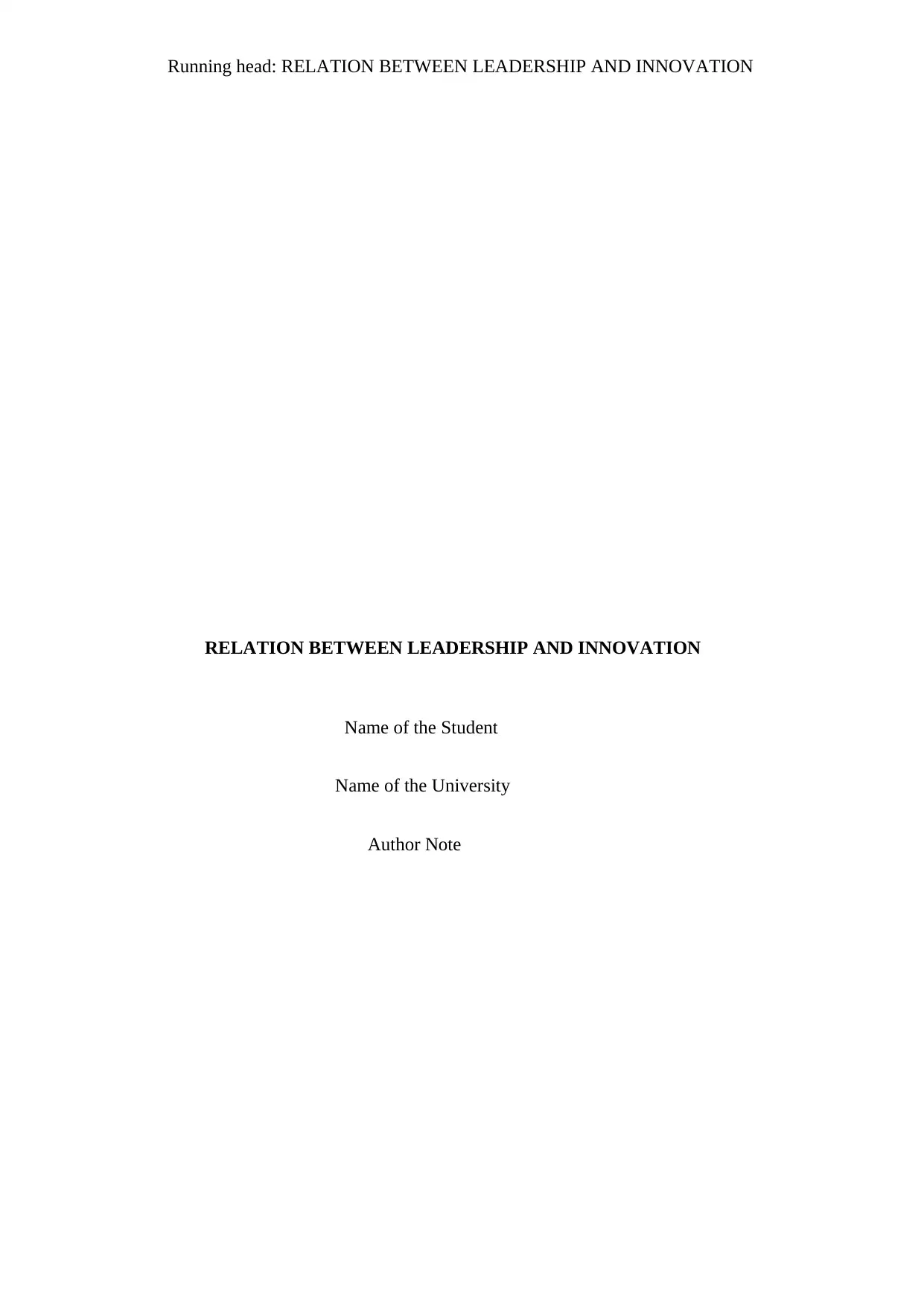
Running head: RELATION BETWEEN LEADERSHIP AND INNOVATION
RELATION BETWEEN LEADERSHIP AND INNOVATION
Name of the Student
Name of the University
Author Note
RELATION BETWEEN LEADERSHIP AND INNOVATION
Name of the Student
Name of the University
Author Note
Paraphrase This Document
Need a fresh take? Get an instant paraphrase of this document with our AI Paraphraser
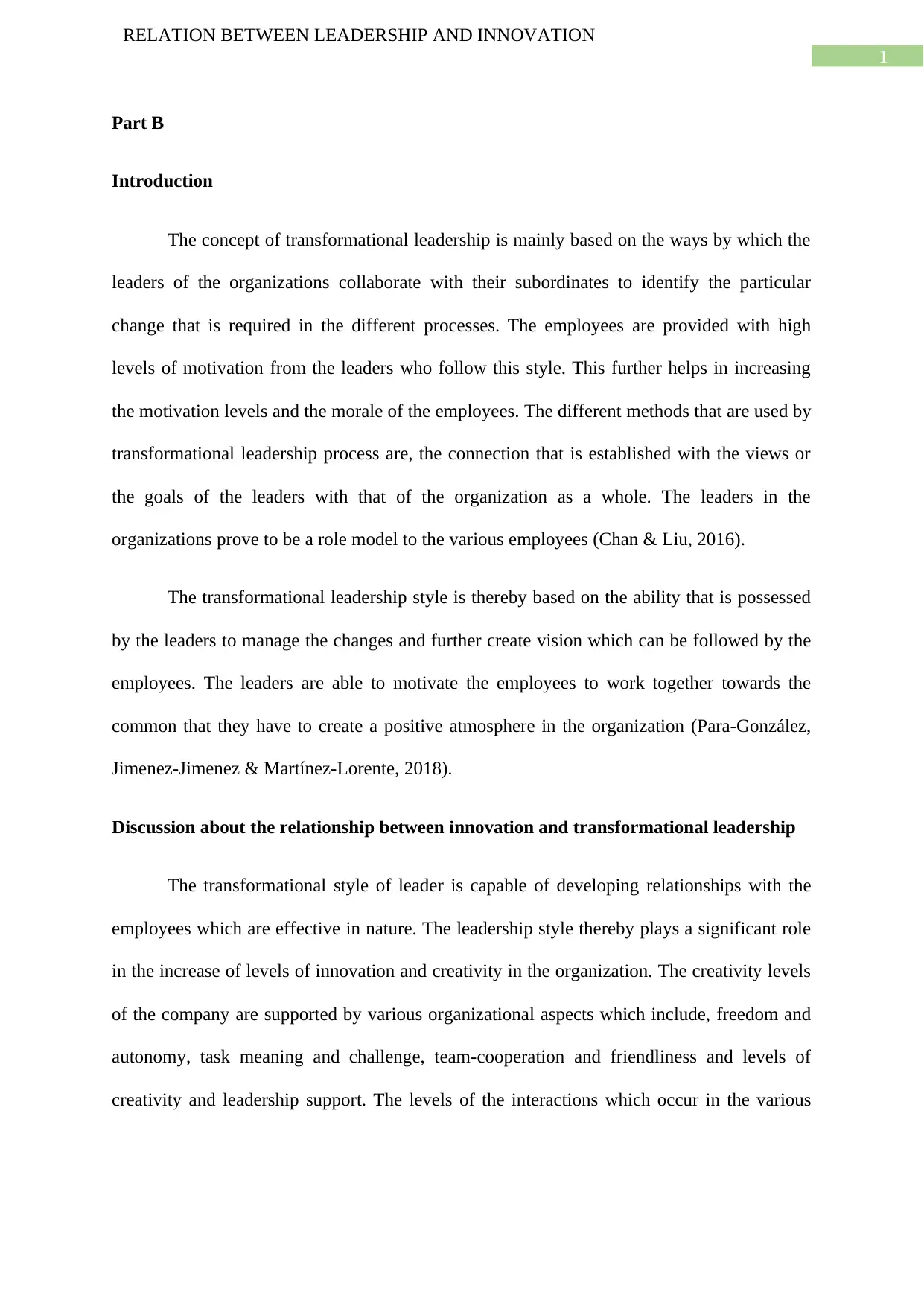
1
RELATION BETWEEN LEADERSHIP AND INNOVATION
Part B
Introduction
The concept of transformational leadership is mainly based on the ways by which the
leaders of the organizations collaborate with their subordinates to identify the particular
change that is required in the different processes. The employees are provided with high
levels of motivation from the leaders who follow this style. This further helps in increasing
the motivation levels and the morale of the employees. The different methods that are used by
transformational leadership process are, the connection that is established with the views or
the goals of the leaders with that of the organization as a whole. The leaders in the
organizations prove to be a role model to the various employees (Chan & Liu, 2016).
The transformational leadership style is thereby based on the ability that is possessed
by the leaders to manage the changes and further create vision which can be followed by the
employees. The leaders are able to motivate the employees to work together towards the
common that they have to create a positive atmosphere in the organization (Para-González,
Jimenez-Jimenez & Martínez-Lorente, 2018).
Discussion about the relationship between innovation and transformational leadership
The transformational style of leader is capable of developing relationships with the
employees which are effective in nature. The leadership style thereby plays a significant role
in the increase of levels of innovation and creativity in the organization. The creativity levels
of the company are supported by various organizational aspects which include, freedom and
autonomy, task meaning and challenge, team-cooperation and friendliness and levels of
creativity and leadership support. The levels of the interactions which occur in the various
RELATION BETWEEN LEADERSHIP AND INNOVATION
Part B
Introduction
The concept of transformational leadership is mainly based on the ways by which the
leaders of the organizations collaborate with their subordinates to identify the particular
change that is required in the different processes. The employees are provided with high
levels of motivation from the leaders who follow this style. This further helps in increasing
the motivation levels and the morale of the employees. The different methods that are used by
transformational leadership process are, the connection that is established with the views or
the goals of the leaders with that of the organization as a whole. The leaders in the
organizations prove to be a role model to the various employees (Chan & Liu, 2016).
The transformational leadership style is thereby based on the ability that is possessed
by the leaders to manage the changes and further create vision which can be followed by the
employees. The leaders are able to motivate the employees to work together towards the
common that they have to create a positive atmosphere in the organization (Para-González,
Jimenez-Jimenez & Martínez-Lorente, 2018).
Discussion about the relationship between innovation and transformational leadership
The transformational style of leader is capable of developing relationships with the
employees which are effective in nature. The leadership style thereby plays a significant role
in the increase of levels of innovation and creativity in the organization. The creativity levels
of the company are supported by various organizational aspects which include, freedom and
autonomy, task meaning and challenge, team-cooperation and friendliness and levels of
creativity and leadership support. The levels of the interactions which occur in the various
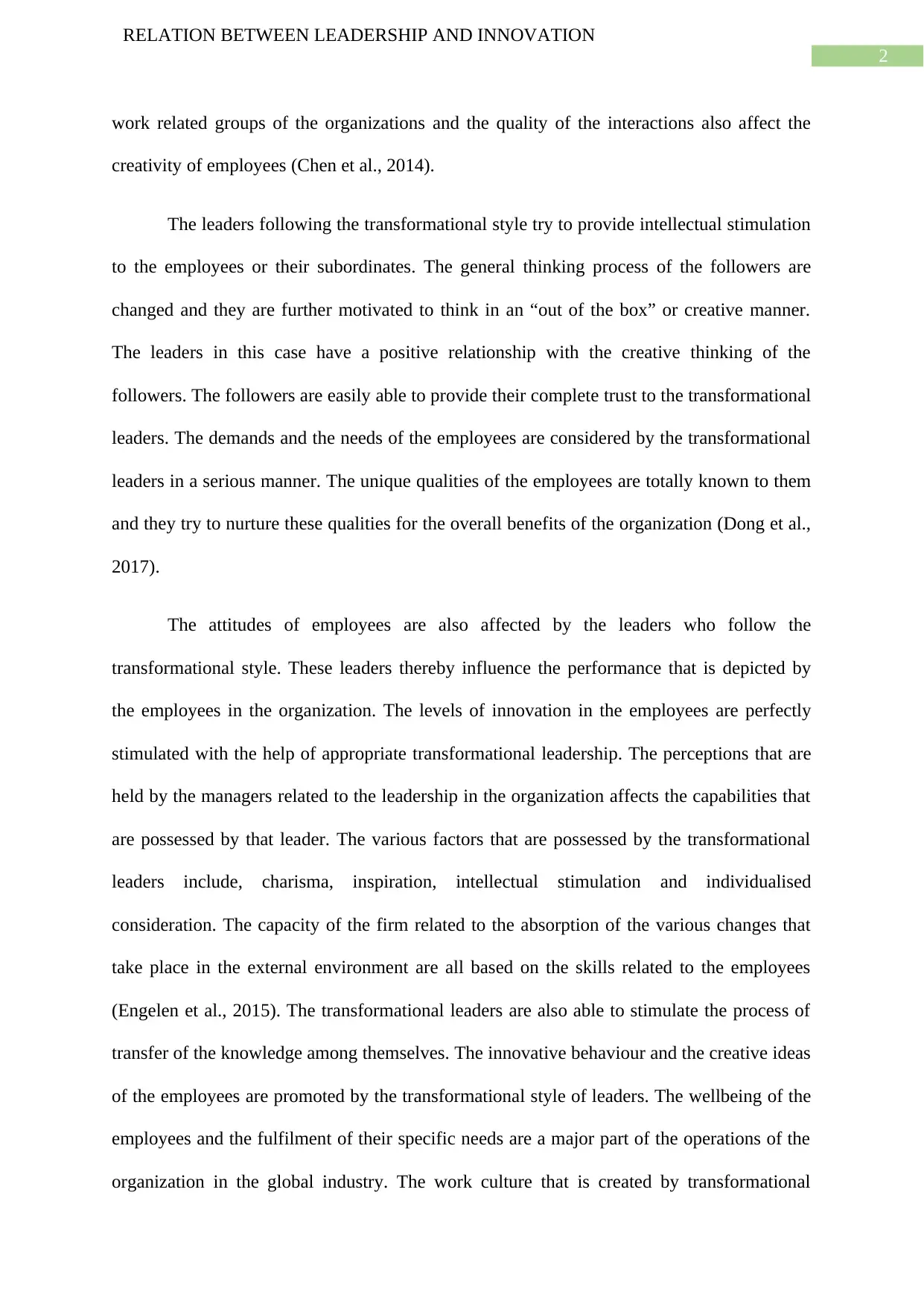
2
RELATION BETWEEN LEADERSHIP AND INNOVATION
work related groups of the organizations and the quality of the interactions also affect the
creativity of employees (Chen et al., 2014).
The leaders following the transformational style try to provide intellectual stimulation
to the employees or their subordinates. The general thinking process of the followers are
changed and they are further motivated to think in an “out of the box” or creative manner.
The leaders in this case have a positive relationship with the creative thinking of the
followers. The followers are easily able to provide their complete trust to the transformational
leaders. The demands and the needs of the employees are considered by the transformational
leaders in a serious manner. The unique qualities of the employees are totally known to them
and they try to nurture these qualities for the overall benefits of the organization (Dong et al.,
2017).
The attitudes of employees are also affected by the leaders who follow the
transformational style. These leaders thereby influence the performance that is depicted by
the employees in the organization. The levels of innovation in the employees are perfectly
stimulated with the help of appropriate transformational leadership. The perceptions that are
held by the managers related to the leadership in the organization affects the capabilities that
are possessed by that leader. The various factors that are possessed by the transformational
leaders include, charisma, inspiration, intellectual stimulation and individualised
consideration. The capacity of the firm related to the absorption of the various changes that
take place in the external environment are all based on the skills related to the employees
(Engelen et al., 2015). The transformational leaders are also able to stimulate the process of
transfer of the knowledge among themselves. The innovative behaviour and the creative ideas
of the employees are promoted by the transformational style of leaders. The wellbeing of the
employees and the fulfilment of their specific needs are a major part of the operations of the
organization in the global industry. The work culture that is created by transformational
RELATION BETWEEN LEADERSHIP AND INNOVATION
work related groups of the organizations and the quality of the interactions also affect the
creativity of employees (Chen et al., 2014).
The leaders following the transformational style try to provide intellectual stimulation
to the employees or their subordinates. The general thinking process of the followers are
changed and they are further motivated to think in an “out of the box” or creative manner.
The leaders in this case have a positive relationship with the creative thinking of the
followers. The followers are easily able to provide their complete trust to the transformational
leaders. The demands and the needs of the employees are considered by the transformational
leaders in a serious manner. The unique qualities of the employees are totally known to them
and they try to nurture these qualities for the overall benefits of the organization (Dong et al.,
2017).
The attitudes of employees are also affected by the leaders who follow the
transformational style. These leaders thereby influence the performance that is depicted by
the employees in the organization. The levels of innovation in the employees are perfectly
stimulated with the help of appropriate transformational leadership. The perceptions that are
held by the managers related to the leadership in the organization affects the capabilities that
are possessed by that leader. The various factors that are possessed by the transformational
leaders include, charisma, inspiration, intellectual stimulation and individualised
consideration. The capacity of the firm related to the absorption of the various changes that
take place in the external environment are all based on the skills related to the employees
(Engelen et al., 2015). The transformational leaders are also able to stimulate the process of
transfer of the knowledge among themselves. The innovative behaviour and the creative ideas
of the employees are promoted by the transformational style of leaders. The wellbeing of the
employees and the fulfilment of their specific needs are a major part of the operations of the
organization in the global industry. The work culture that is created by transformational
⊘ This is a preview!⊘
Do you want full access?
Subscribe today to unlock all pages.

Trusted by 1+ million students worldwide
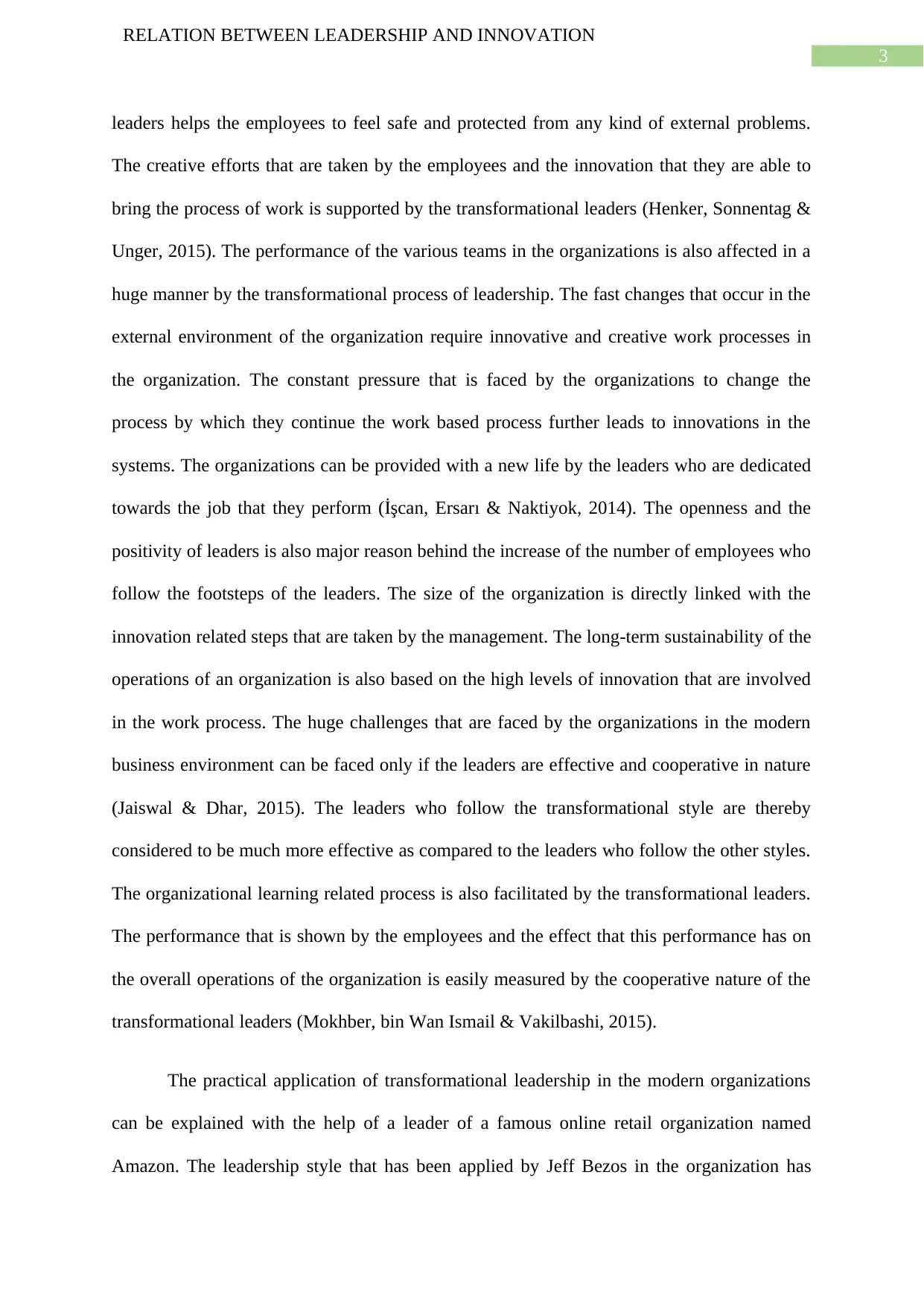
3
RELATION BETWEEN LEADERSHIP AND INNOVATION
leaders helps the employees to feel safe and protected from any kind of external problems.
The creative efforts that are taken by the employees and the innovation that they are able to
bring the process of work is supported by the transformational leaders (Henker, Sonnentag &
Unger, 2015). The performance of the various teams in the organizations is also affected in a
huge manner by the transformational process of leadership. The fast changes that occur in the
external environment of the organization require innovative and creative work processes in
the organization. The constant pressure that is faced by the organizations to change the
process by which they continue the work based process further leads to innovations in the
systems. The organizations can be provided with a new life by the leaders who are dedicated
towards the job that they perform (İşcan, Ersarı & Naktiyok, 2014). The openness and the
positivity of leaders is also major reason behind the increase of the number of employees who
follow the footsteps of the leaders. The size of the organization is directly linked with the
innovation related steps that are taken by the management. The long-term sustainability of the
operations of an organization is also based on the high levels of innovation that are involved
in the work process. The huge challenges that are faced by the organizations in the modern
business environment can be faced only if the leaders are effective and cooperative in nature
(Jaiswal & Dhar, 2015). The leaders who follow the transformational style are thereby
considered to be much more effective as compared to the leaders who follow the other styles.
The organizational learning related process is also facilitated by the transformational leaders.
The performance that is shown by the employees and the effect that this performance has on
the overall operations of the organization is easily measured by the cooperative nature of the
transformational leaders (Mokhber, bin Wan Ismail & Vakilbashi, 2015).
The practical application of transformational leadership in the modern organizations
can be explained with the help of a leader of a famous online retail organization named
Amazon. The leadership style that has been applied by Jeff Bezos in the organization has
RELATION BETWEEN LEADERSHIP AND INNOVATION
leaders helps the employees to feel safe and protected from any kind of external problems.
The creative efforts that are taken by the employees and the innovation that they are able to
bring the process of work is supported by the transformational leaders (Henker, Sonnentag &
Unger, 2015). The performance of the various teams in the organizations is also affected in a
huge manner by the transformational process of leadership. The fast changes that occur in the
external environment of the organization require innovative and creative work processes in
the organization. The constant pressure that is faced by the organizations to change the
process by which they continue the work based process further leads to innovations in the
systems. The organizations can be provided with a new life by the leaders who are dedicated
towards the job that they perform (İşcan, Ersarı & Naktiyok, 2014). The openness and the
positivity of leaders is also major reason behind the increase of the number of employees who
follow the footsteps of the leaders. The size of the organization is directly linked with the
innovation related steps that are taken by the management. The long-term sustainability of the
operations of an organization is also based on the high levels of innovation that are involved
in the work process. The huge challenges that are faced by the organizations in the modern
business environment can be faced only if the leaders are effective and cooperative in nature
(Jaiswal & Dhar, 2015). The leaders who follow the transformational style are thereby
considered to be much more effective as compared to the leaders who follow the other styles.
The organizational learning related process is also facilitated by the transformational leaders.
The performance that is shown by the employees and the effect that this performance has on
the overall operations of the organization is easily measured by the cooperative nature of the
transformational leaders (Mokhber, bin Wan Ismail & Vakilbashi, 2015).
The practical application of transformational leadership in the modern organizations
can be explained with the help of a leader of a famous online retail organization named
Amazon. The leadership style that has been applied by Jeff Bezos in the organization has
Paraphrase This Document
Need a fresh take? Get an instant paraphrase of this document with our AI Paraphraser
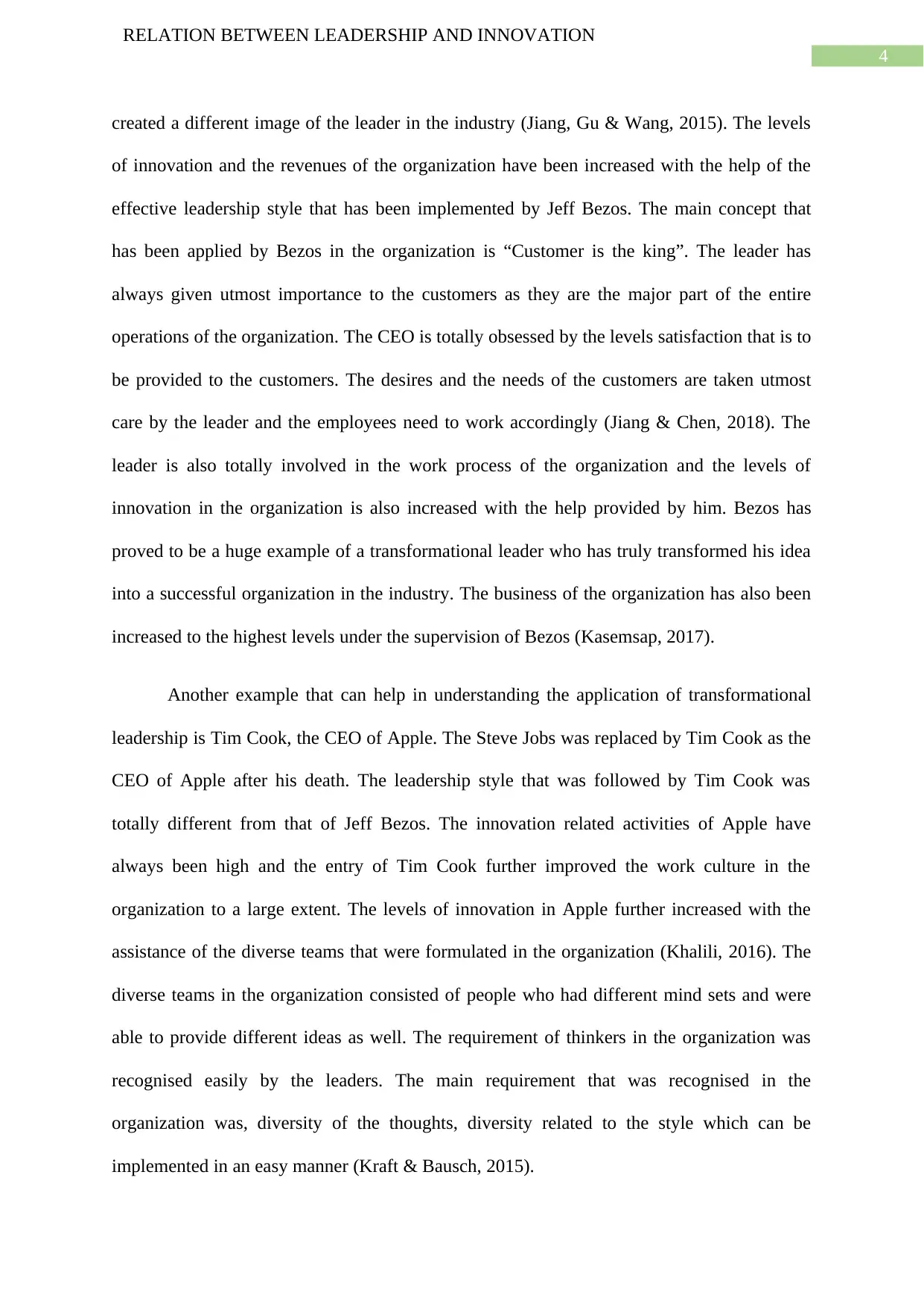
4
RELATION BETWEEN LEADERSHIP AND INNOVATION
created a different image of the leader in the industry (Jiang, Gu & Wang, 2015). The levels
of innovation and the revenues of the organization have been increased with the help of the
effective leadership style that has been implemented by Jeff Bezos. The main concept that
has been applied by Bezos in the organization is “Customer is the king”. The leader has
always given utmost importance to the customers as they are the major part of the entire
operations of the organization. The CEO is totally obsessed by the levels satisfaction that is to
be provided to the customers. The desires and the needs of the customers are taken utmost
care by the leader and the employees need to work accordingly (Jiang & Chen, 2018). The
leader is also totally involved in the work process of the organization and the levels of
innovation in the organization is also increased with the help provided by him. Bezos has
proved to be a huge example of a transformational leader who has truly transformed his idea
into a successful organization in the industry. The business of the organization has also been
increased to the highest levels under the supervision of Bezos (Kasemsap, 2017).
Another example that can help in understanding the application of transformational
leadership is Tim Cook, the CEO of Apple. The Steve Jobs was replaced by Tim Cook as the
CEO of Apple after his death. The leadership style that was followed by Tim Cook was
totally different from that of Jeff Bezos. The innovation related activities of Apple have
always been high and the entry of Tim Cook further improved the work culture in the
organization to a large extent. The levels of innovation in Apple further increased with the
assistance of the diverse teams that were formulated in the organization (Khalili, 2016). The
diverse teams in the organization consisted of people who had different mind sets and were
able to provide different ideas as well. The requirement of thinkers in the organization was
recognised easily by the leaders. The main requirement that was recognised in the
organization was, diversity of the thoughts, diversity related to the style which can be
implemented in an easy manner (Kraft & Bausch, 2015).
RELATION BETWEEN LEADERSHIP AND INNOVATION
created a different image of the leader in the industry (Jiang, Gu & Wang, 2015). The levels
of innovation and the revenues of the organization have been increased with the help of the
effective leadership style that has been implemented by Jeff Bezos. The main concept that
has been applied by Bezos in the organization is “Customer is the king”. The leader has
always given utmost importance to the customers as they are the major part of the entire
operations of the organization. The CEO is totally obsessed by the levels satisfaction that is to
be provided to the customers. The desires and the needs of the customers are taken utmost
care by the leader and the employees need to work accordingly (Jiang & Chen, 2018). The
leader is also totally involved in the work process of the organization and the levels of
innovation in the organization is also increased with the help provided by him. Bezos has
proved to be a huge example of a transformational leader who has truly transformed his idea
into a successful organization in the industry. The business of the organization has also been
increased to the highest levels under the supervision of Bezos (Kasemsap, 2017).
Another example that can help in understanding the application of transformational
leadership is Tim Cook, the CEO of Apple. The Steve Jobs was replaced by Tim Cook as the
CEO of Apple after his death. The leadership style that was followed by Tim Cook was
totally different from that of Jeff Bezos. The innovation related activities of Apple have
always been high and the entry of Tim Cook further improved the work culture in the
organization to a large extent. The levels of innovation in Apple further increased with the
assistance of the diverse teams that were formulated in the organization (Khalili, 2016). The
diverse teams in the organization consisted of people who had different mind sets and were
able to provide different ideas as well. The requirement of thinkers in the organization was
recognised easily by the leaders. The main requirement that was recognised in the
organization was, diversity of the thoughts, diversity related to the style which can be
implemented in an easy manner (Kraft & Bausch, 2015).
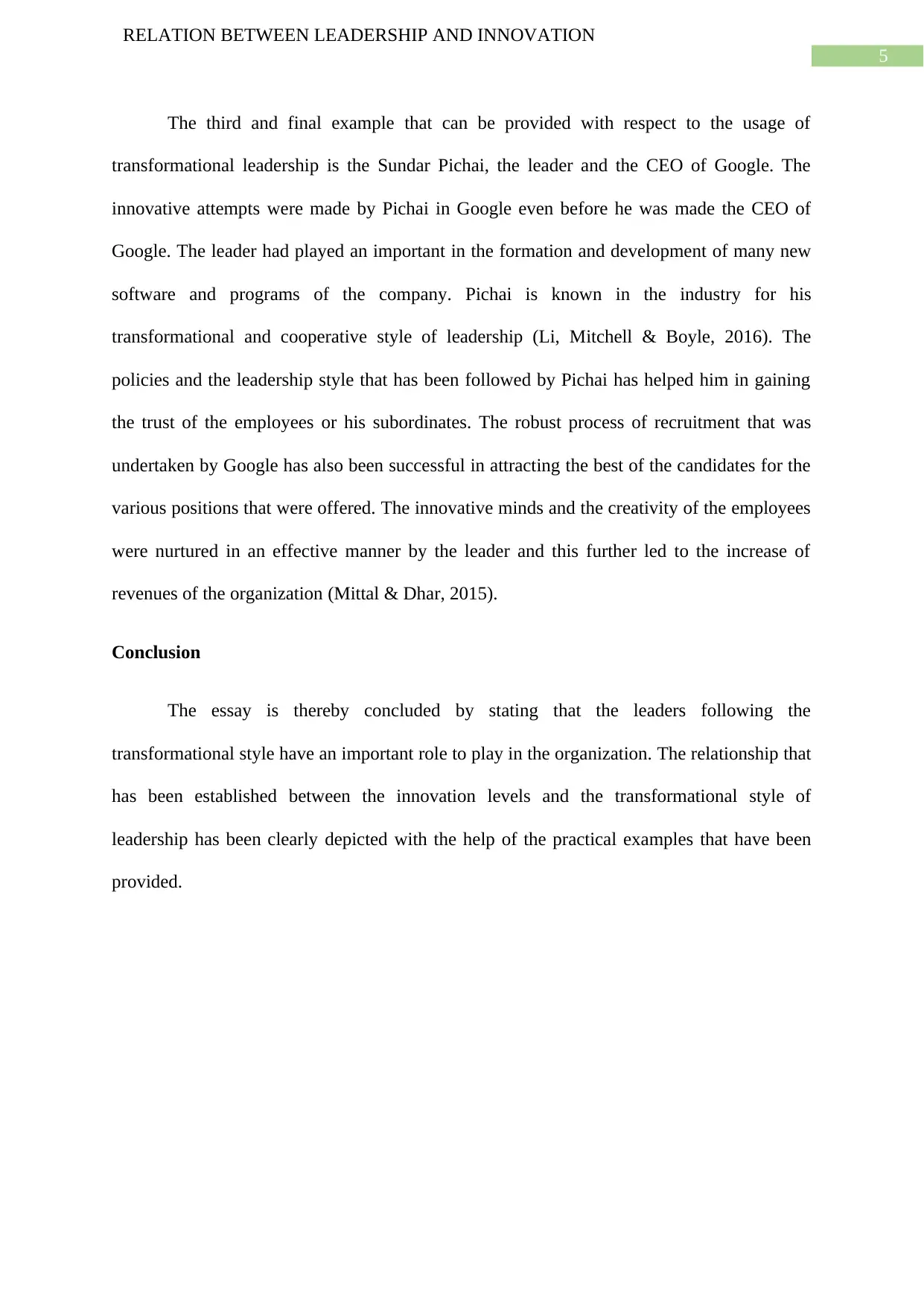
5
RELATION BETWEEN LEADERSHIP AND INNOVATION
The third and final example that can be provided with respect to the usage of
transformational leadership is the Sundar Pichai, the leader and the CEO of Google. The
innovative attempts were made by Pichai in Google even before he was made the CEO of
Google. The leader had played an important in the formation and development of many new
software and programs of the company. Pichai is known in the industry for his
transformational and cooperative style of leadership (Li, Mitchell & Boyle, 2016). The
policies and the leadership style that has been followed by Pichai has helped him in gaining
the trust of the employees or his subordinates. The robust process of recruitment that was
undertaken by Google has also been successful in attracting the best of the candidates for the
various positions that were offered. The innovative minds and the creativity of the employees
were nurtured in an effective manner by the leader and this further led to the increase of
revenues of the organization (Mittal & Dhar, 2015).
Conclusion
The essay is thereby concluded by stating that the leaders following the
transformational style have an important role to play in the organization. The relationship that
has been established between the innovation levels and the transformational style of
leadership has been clearly depicted with the help of the practical examples that have been
provided.
RELATION BETWEEN LEADERSHIP AND INNOVATION
The third and final example that can be provided with respect to the usage of
transformational leadership is the Sundar Pichai, the leader and the CEO of Google. The
innovative attempts were made by Pichai in Google even before he was made the CEO of
Google. The leader had played an important in the formation and development of many new
software and programs of the company. Pichai is known in the industry for his
transformational and cooperative style of leadership (Li, Mitchell & Boyle, 2016). The
policies and the leadership style that has been followed by Pichai has helped him in gaining
the trust of the employees or his subordinates. The robust process of recruitment that was
undertaken by Google has also been successful in attracting the best of the candidates for the
various positions that were offered. The innovative minds and the creativity of the employees
were nurtured in an effective manner by the leader and this further led to the increase of
revenues of the organization (Mittal & Dhar, 2015).
Conclusion
The essay is thereby concluded by stating that the leaders following the
transformational style have an important role to play in the organization. The relationship that
has been established between the innovation levels and the transformational style of
leadership has been clearly depicted with the help of the practical examples that have been
provided.
⊘ This is a preview!⊘
Do you want full access?
Subscribe today to unlock all pages.

Trusted by 1+ million students worldwide
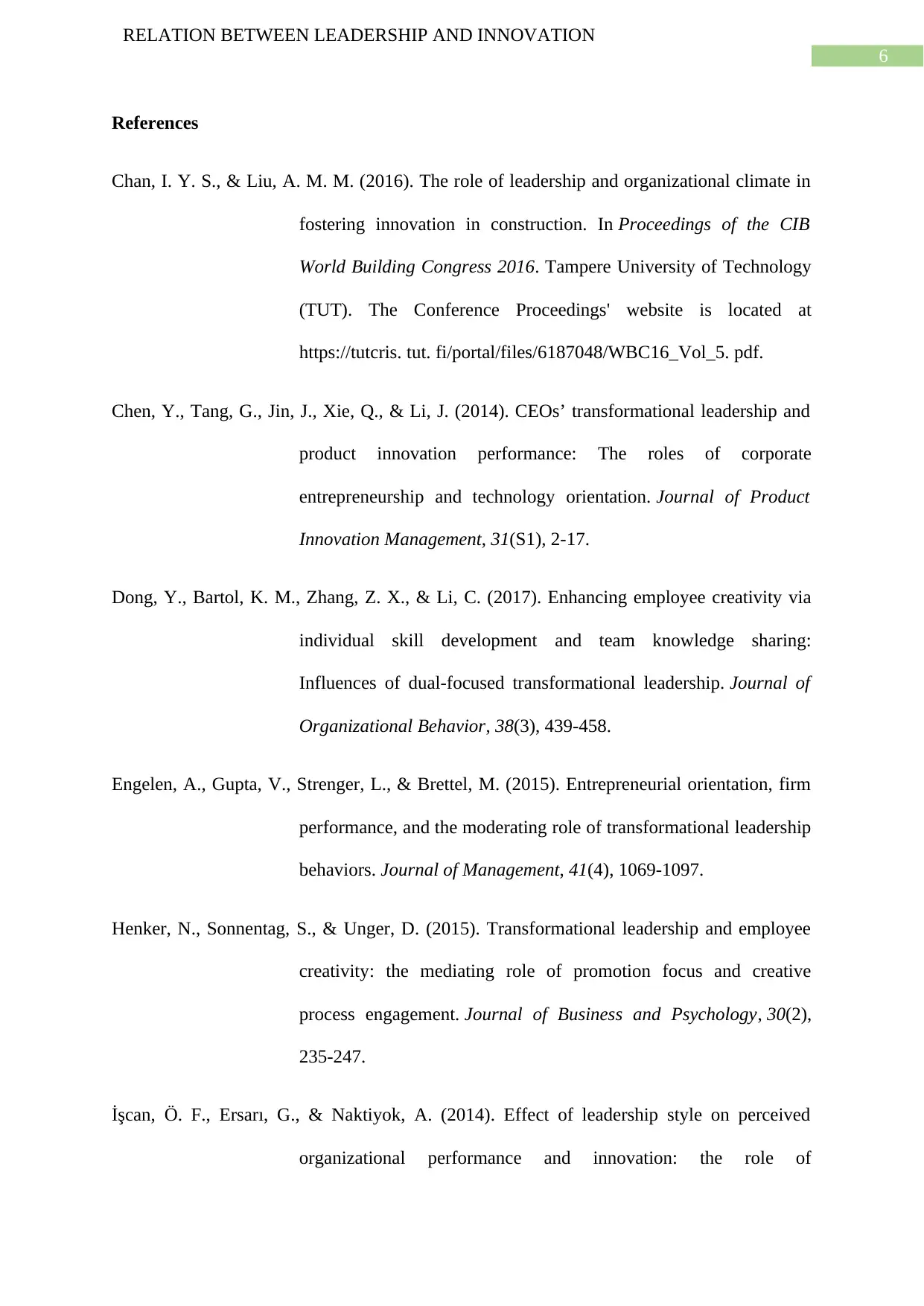
6
RELATION BETWEEN LEADERSHIP AND INNOVATION
References
Chan, I. Y. S., & Liu, A. M. M. (2016). The role of leadership and organizational climate in
fostering innovation in construction. In Proceedings of the CIB
World Building Congress 2016. Tampere University of Technology
(TUT). The Conference Proceedings' website is located at
https://tutcris. tut. fi/portal/files/6187048/WBC16_Vol_5. pdf.
Chen, Y., Tang, G., Jin, J., Xie, Q., & Li, J. (2014). CEOs’ transformational leadership and
product innovation performance: The roles of corporate
entrepreneurship and technology orientation. Journal of Product
Innovation Management, 31(S1), 2-17.
Dong, Y., Bartol, K. M., Zhang, Z. X., & Li, C. (2017). Enhancing employee creativity via
individual skill development and team knowledge sharing:
Influences of dual‐focused transformational leadership. Journal of
Organizational Behavior, 38(3), 439-458.
Engelen, A., Gupta, V., Strenger, L., & Brettel, M. (2015). Entrepreneurial orientation, firm
performance, and the moderating role of transformational leadership
behaviors. Journal of Management, 41(4), 1069-1097.
Henker, N., Sonnentag, S., & Unger, D. (2015). Transformational leadership and employee
creativity: the mediating role of promotion focus and creative
process engagement. Journal of Business and Psychology, 30(2),
235-247.
İşcan, Ö. F., Ersarı, G., & Naktiyok, A. (2014). Effect of leadership style on perceived
organizational performance and innovation: the role of
RELATION BETWEEN LEADERSHIP AND INNOVATION
References
Chan, I. Y. S., & Liu, A. M. M. (2016). The role of leadership and organizational climate in
fostering innovation in construction. In Proceedings of the CIB
World Building Congress 2016. Tampere University of Technology
(TUT). The Conference Proceedings' website is located at
https://tutcris. tut. fi/portal/files/6187048/WBC16_Vol_5. pdf.
Chen, Y., Tang, G., Jin, J., Xie, Q., & Li, J. (2014). CEOs’ transformational leadership and
product innovation performance: The roles of corporate
entrepreneurship and technology orientation. Journal of Product
Innovation Management, 31(S1), 2-17.
Dong, Y., Bartol, K. M., Zhang, Z. X., & Li, C. (2017). Enhancing employee creativity via
individual skill development and team knowledge sharing:
Influences of dual‐focused transformational leadership. Journal of
Organizational Behavior, 38(3), 439-458.
Engelen, A., Gupta, V., Strenger, L., & Brettel, M. (2015). Entrepreneurial orientation, firm
performance, and the moderating role of transformational leadership
behaviors. Journal of Management, 41(4), 1069-1097.
Henker, N., Sonnentag, S., & Unger, D. (2015). Transformational leadership and employee
creativity: the mediating role of promotion focus and creative
process engagement. Journal of Business and Psychology, 30(2),
235-247.
İşcan, Ö. F., Ersarı, G., & Naktiyok, A. (2014). Effect of leadership style on perceived
organizational performance and innovation: the role of
Paraphrase This Document
Need a fresh take? Get an instant paraphrase of this document with our AI Paraphraser
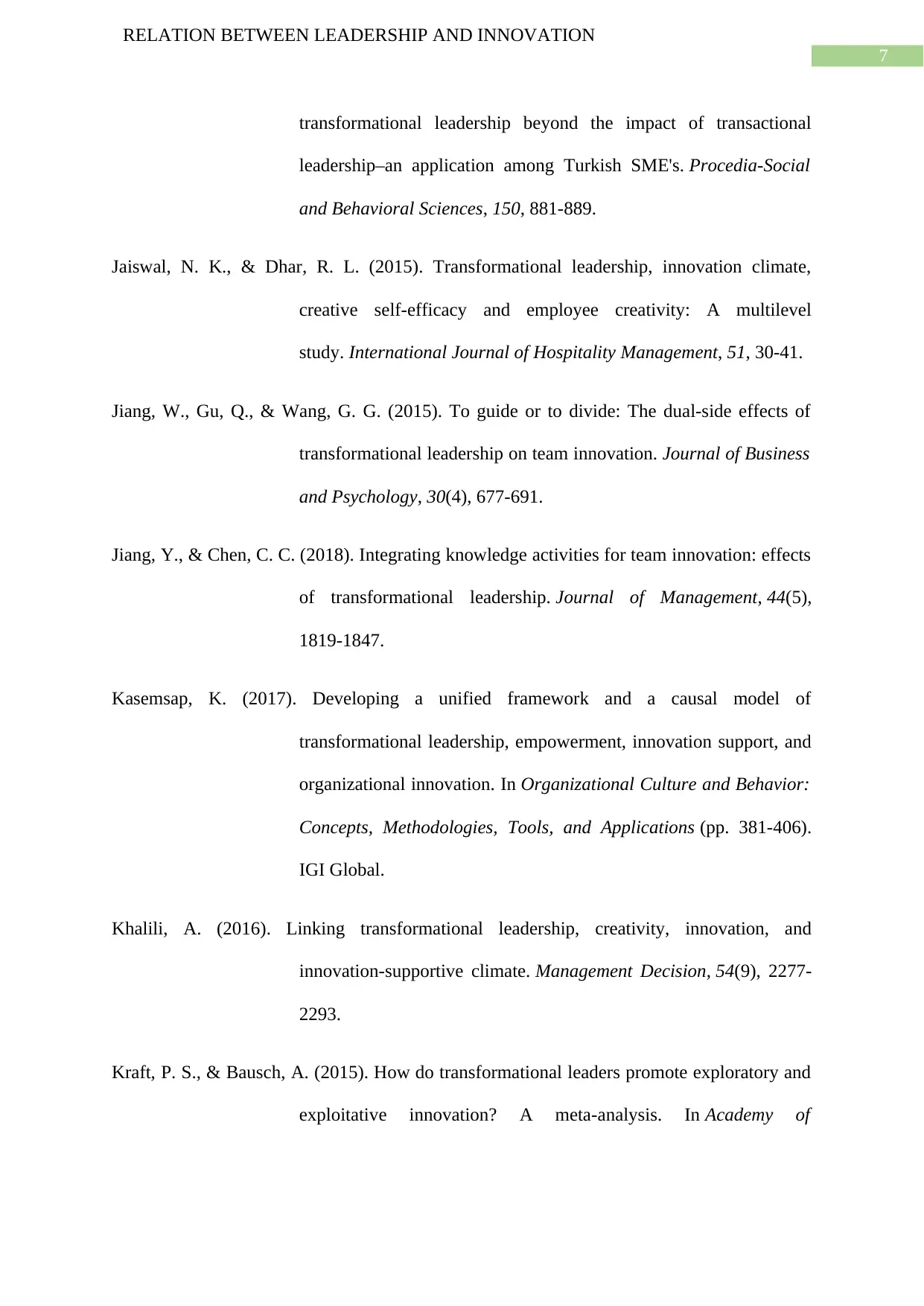
7
RELATION BETWEEN LEADERSHIP AND INNOVATION
transformational leadership beyond the impact of transactional
leadership–an application among Turkish SME's. Procedia-Social
and Behavioral Sciences, 150, 881-889.
Jaiswal, N. K., & Dhar, R. L. (2015). Transformational leadership, innovation climate,
creative self-efficacy and employee creativity: A multilevel
study. International Journal of Hospitality Management, 51, 30-41.
Jiang, W., Gu, Q., & Wang, G. G. (2015). To guide or to divide: The dual-side effects of
transformational leadership on team innovation. Journal of Business
and Psychology, 30(4), 677-691.
Jiang, Y., & Chen, C. C. (2018). Integrating knowledge activities for team innovation: effects
of transformational leadership. Journal of Management, 44(5),
1819-1847.
Kasemsap, K. (2017). Developing a unified framework and a causal model of
transformational leadership, empowerment, innovation support, and
organizational innovation. In Organizational Culture and Behavior:
Concepts, Methodologies, Tools, and Applications (pp. 381-406).
IGI Global.
Khalili, A. (2016). Linking transformational leadership, creativity, innovation, and
innovation-supportive climate. Management Decision, 54(9), 2277-
2293.
Kraft, P. S., & Bausch, A. (2015). How do transformational leaders promote exploratory and
exploitative innovation? A meta-analysis. In Academy of
RELATION BETWEEN LEADERSHIP AND INNOVATION
transformational leadership beyond the impact of transactional
leadership–an application among Turkish SME's. Procedia-Social
and Behavioral Sciences, 150, 881-889.
Jaiswal, N. K., & Dhar, R. L. (2015). Transformational leadership, innovation climate,
creative self-efficacy and employee creativity: A multilevel
study. International Journal of Hospitality Management, 51, 30-41.
Jiang, W., Gu, Q., & Wang, G. G. (2015). To guide or to divide: The dual-side effects of
transformational leadership on team innovation. Journal of Business
and Psychology, 30(4), 677-691.
Jiang, Y., & Chen, C. C. (2018). Integrating knowledge activities for team innovation: effects
of transformational leadership. Journal of Management, 44(5),
1819-1847.
Kasemsap, K. (2017). Developing a unified framework and a causal model of
transformational leadership, empowerment, innovation support, and
organizational innovation. In Organizational Culture and Behavior:
Concepts, Methodologies, Tools, and Applications (pp. 381-406).
IGI Global.
Khalili, A. (2016). Linking transformational leadership, creativity, innovation, and
innovation-supportive climate. Management Decision, 54(9), 2277-
2293.
Kraft, P. S., & Bausch, A. (2015). How do transformational leaders promote exploratory and
exploitative innovation? A meta-analysis. In Academy of
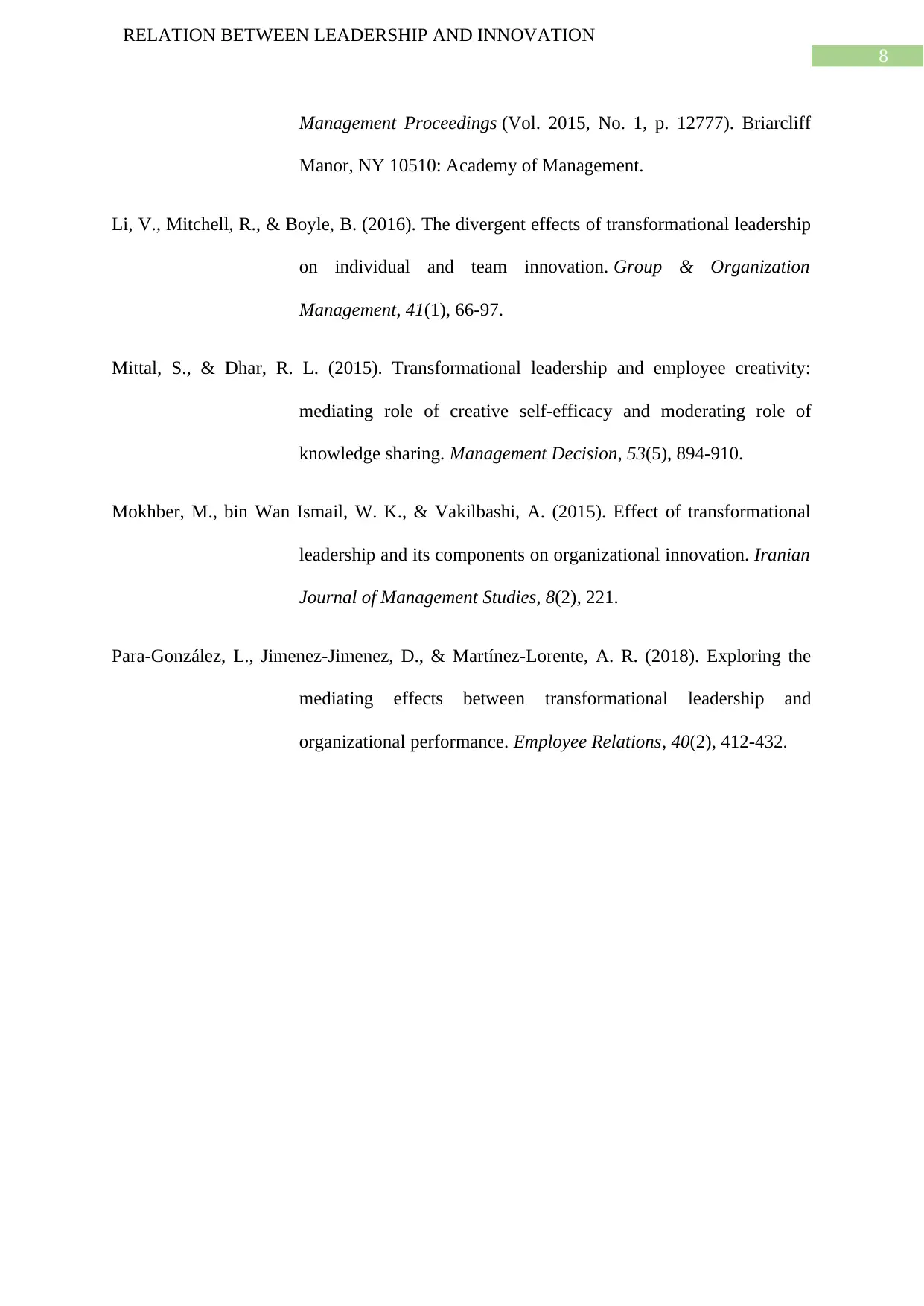
8
RELATION BETWEEN LEADERSHIP AND INNOVATION
Management Proceedings (Vol. 2015, No. 1, p. 12777). Briarcliff
Manor, NY 10510: Academy of Management.
Li, V., Mitchell, R., & Boyle, B. (2016). The divergent effects of transformational leadership
on individual and team innovation. Group & Organization
Management, 41(1), 66-97.
Mittal, S., & Dhar, R. L. (2015). Transformational leadership and employee creativity:
mediating role of creative self-efficacy and moderating role of
knowledge sharing. Management Decision, 53(5), 894-910.
Mokhber, M., bin Wan Ismail, W. K., & Vakilbashi, A. (2015). Effect of transformational
leadership and its components on organizational innovation. Iranian
Journal of Management Studies, 8(2), 221.
Para-González, L., Jimenez-Jimenez, D., & Martínez-Lorente, A. R. (2018). Exploring the
mediating effects between transformational leadership and
organizational performance. Employee Relations, 40(2), 412-432.
RELATION BETWEEN LEADERSHIP AND INNOVATION
Management Proceedings (Vol. 2015, No. 1, p. 12777). Briarcliff
Manor, NY 10510: Academy of Management.
Li, V., Mitchell, R., & Boyle, B. (2016). The divergent effects of transformational leadership
on individual and team innovation. Group & Organization
Management, 41(1), 66-97.
Mittal, S., & Dhar, R. L. (2015). Transformational leadership and employee creativity:
mediating role of creative self-efficacy and moderating role of
knowledge sharing. Management Decision, 53(5), 894-910.
Mokhber, M., bin Wan Ismail, W. K., & Vakilbashi, A. (2015). Effect of transformational
leadership and its components on organizational innovation. Iranian
Journal of Management Studies, 8(2), 221.
Para-González, L., Jimenez-Jimenez, D., & Martínez-Lorente, A. R. (2018). Exploring the
mediating effects between transformational leadership and
organizational performance. Employee Relations, 40(2), 412-432.
⊘ This is a preview!⊘
Do you want full access?
Subscribe today to unlock all pages.

Trusted by 1+ million students worldwide
1 out of 9
Related Documents
Your All-in-One AI-Powered Toolkit for Academic Success.
+13062052269
info@desklib.com
Available 24*7 on WhatsApp / Email
![[object Object]](/_next/static/media/star-bottom.7253800d.svg)
Unlock your academic potential
Copyright © 2020–2025 A2Z Services. All Rights Reserved. Developed and managed by ZUCOL.





